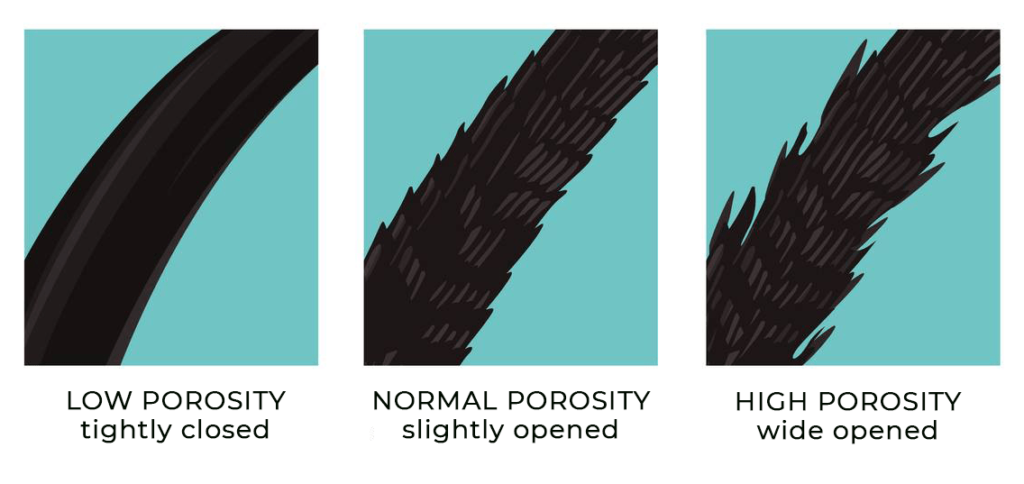Did you know that your hair type isn’t the only factor you should consider when trying to find the right products for your hair? Your hair’s porosity is actually a better indicator to help you determine how a product will perform.
So, what is hair porosity?
Hair porosity is a phrase that refers to your hair’s ability to absorb and retain moisture. The porosity of your hair affects how well moisture passes through the outermost layer of hair, known as the cuticle.
To fully understand the concept of hair porosity, you must first understand the basic structure of your hair. The hair consists of three layers which are:
- The medulla – the soft, central part of the hair shaft.
- The cortex – the thickest layer of your hair which contains fibrous proteins. It also gives your hair it’s pigment.
- The cuticle – the protective layer of your hair that’s made up of cuticles (imagine shingles on a roof) that overlap each other.

The three types of hair porosity are:
Low porosity hair has tightly closed hair cuticles that make it harder for moisture to penetrate the hair shaft. It’s hard for water to saturate your hair when washing and hair products typically sit on top of the hair strands. It also takes low porosity hair longer to dry. In essence, it’s hard for low porosity hair to absorb water but it retains moisture well.
Normal porosity hair has hair cuticles that aren’t too tight or too open. It’s typically easy to style normal porosity hair and styles last for a good amount of time. It doesn’t take too long for the hair to dry. Normal porosity hair absorbs and retains moisture well.
High porosity hair has open or widely spaced hair cuticles. Water can easily penetrate the hair shaft but the hair can also break easily and become dry quicker. High porosity hair doesn’t take too much time to dry and can absorb moisture well. However, it has a hard time retaining moisture.
What causes high or low porosity and can it be changed?
Your hair’s porosity is largely determined by your genetics but there are factors that can determine your hair’s porosity as well.
Damage to the hair due to the excessive use of heat, bleaching, certain hair treatments, or overwashing can all lead to damage over time. These processes can raise the hair cuticle making it hard to retain moisture. Laying off of these things and allowing your hair to grow out, and getting rid of the damage, can help your hair get back to its original porosity.
Since your genetics play a huge role in the porosity of your hair, you may not be able to change it. However, there are some things that you can do to make sure your hair stays healthy and easier to manage.
For low porosity hair:
Try using protein-free conditioners and apply them to hair that’s already wet. After applying, put on a plastic cap and sit under a hooded dryer with low heat and medium airflow to help gently lift the hair cuticle for 15-30 minutes. This will allow the product to be more easily absorbed by your hair. Wait until your hair has cooled before rinsing. Also, look for products with glycerin or honey. Both of these are humectants that draw moisture from the atmosphere into your hair. If you live in a dry climate, humectants may not be for you because they will do the opposite, pull moisture from the deeper layers of your hair.
For high porosity hair:
Avoid using water that is too hot on your hair. Using water that is too hot can cause your hair to dry out. When styling your hair, be sure to use a moisturizing leave-in with water as the first ingredient and then seal in the moisture with a thicker product, like a cream made with butters or oils. This will help your hair retain moisture longer.

How to Determine Your Hair Porosity
There are multiple methods to find out the porosity of your hair. One of the easiest ways is to do a float test. Here’s how to do it:
- Wash your hair to get rid of any product.
- Fill a glass with lukewarm water.
- Once your hair has dried, drop a single strand into the cup.
- Watch to see if your strand floats or sinks.
If the strand floats at the top before sinking, you likely have low porosity hair. If the strand floats somewhere in the middle, you likely have normal porosity hair. If the strand quickly sinks to the bottom, you likely have high porosity hair.
If you don’t want to do the float test you can try running your thumb and index finger up and down a single strand of hair. High porosity hair will feel rough and bumpy due to the open cuticles while low porosity hair will feel smooth due to the closed cuticles.
The bottom line
For optimal hair health, water and other moisturizing products need to be able to pass through the cuticle to get to the cortex. If the cuticles are too tight, these products will have a tough time getting to the cortex. If they are too wide, your hair will have a tough time staying hydrated. Knowing your hair’s porosity can help you better understand your hair and how to care for it.








